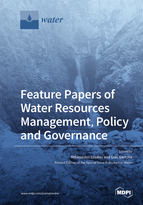Feature Papers of Water Resources Management, Policy and Governance
A special issue of Water (ISSN 2073-4441). This special issue belongs to the section "Water Resources Management, Policy and Governance".
Deadline for manuscript submissions: closed (31 December 2021) | Viewed by 23145
Special Issue Editors
Interests: surface hydrology; water resource management and engineering; climate change impacts on hydrology and water resources; extreme hydrological events (floods and droughts)
Special Issues, Collections and Topics in MDPI journals
Interests: hydrodynamic modeling; water resources; hydrology; vulnerability; climate change; quantitative assessment
Special Issues, Collections and Topics in MDPI journals
Special Issue Information
Dear Colleagues,
Water resource management includes consideration of all disciplines of hydrology and water sources. Water supplies are allocated and diverted to cover water needs of a range of agricultural, municipal, industrial, hydroelectrical, and ecological water uses. Most of the time, these water uses are very compatitive, as the available water resources are limited and it is not possible to cover the total water needs in a hydrological basin, requiring to set water use priorities in a way that serves societal and ecological needs. To manage the water resources and the waterworks constructed to make good use of water may, sometimes, lead to confrontational deliberations and negotiations. As a result, water resource management is one of the world’s greatest challenges due to competition for limited resources, regional disparities in water supply and affluence, mounting global water demand, aquifer depletion, and pollution- and climate-change-induced water stress. Proper policy and governance for integrated sustainable water resource management is essential in a basin and requires new fresh ideas, innovation, and international cooperation.
This Special Issue aims to include papers by invited reputable researchers and engineers to cover issues of water resource management, governance, and policy. These issues may include the following topics:
- Integrated water resource management;
- Management of water resource systems and water availability;
- Monitoring and protection of water resources;
- National and international water policy, institutional arrangements, and water law;
- Water economics and commercialization of water;
- Water conflict resolution, public participation, and decision making;
- Water resource management, policy and governance in socially and environmentally sensitive areas and regions.
Prof. Dr. Athanasios Loukas
Prof. Dr. Luis Garrote
Guest Editors
Manuscript Submission Information
Manuscripts should be submitted online at www.mdpi.com by registering and logging in to this website. Once you are registered, click here to go to the submission form. Manuscripts can be submitted until the deadline. All submissions that pass pre-check are peer-reviewed. Accepted papers will be published continuously in the journal (as soon as accepted) and will be listed together on the special issue website. Research articles, review articles as well as short communications are invited. For planned papers, a title and short abstract (about 100 words) can be sent to the Editorial Office for announcement on this website.
Submitted manuscripts should not have been published previously, nor be under consideration for publication elsewhere (except conference proceedings papers). All manuscripts are thoroughly refereed through a single-blind peer-review process. A guide for authors and other relevant information for submission of manuscripts is available on the Instructions for Authors page. Water is an international peer-reviewed open access semimonthly journal published by MDPI.
Please visit the Instructions for Authors page before submitting a manuscript. The Article Processing Charge (APC) for publication in this open access journal is 2600 CHF (Swiss Francs). Submitted papers should be well formatted and use good English. Authors may use MDPI's English editing service prior to publication or during author revisions.
Keywords
- water resource management
- governance
- policy
- water economics
- conflict resolution
- protection of water resources
- social and environmental sustainability







